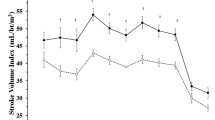Abstract
The measurement of heart rate variation during forced breathing (HRDB) is a well-known clinical test of parasympathetic function. It is known that normal values of HRDB are strongly dependent on age. However, little is known about other physiological factors that may lead to reduced HRDB values that may mimic parasympathetic failure. Thirty-two normal subjects (age 56.7±12.4 years) and 32 neurological patients with pathological autonomic test findings (age 57.9±10.2) were studied. Oscillations in heart rate and in mean arterial blood pressure were recorded in the supine position during forced breathing (6 cycles/min) using the Finapres monitor. Amplitudes of heart rate and blood pressure waves at 6 cycles/min (HR6 and ABP6) as well as gain values (Gain6=HR6/ABP6) and phase differences ({ie131-1}) between HR and ABP waves were calculated by means of spectral analysis. The mean (±SD) HR6 in normal subjects was 6.34±3.36 cycles/min with a mean ABP6 of 5.11±2.49 mmHg. HR6 correlated significantly with age (r=−0.426) and with ABP6 (r=0.602). No significant correlation was found between HR6 and mean blood pressure, mean heart rate or sex. From 24 patients with pathological findings in the classical HRDB value, only nine could be classified as pathological when the effect of ABP6 was considered. In conclusion, ABP variations significantly influence the amplitude of heart rate variations during forced breathing. We interpret these findings in terms of a baroreflex mechanism of HRDB including both vagal and sympathetic efferents. Normal reference value tables for clinical HRDB studies should not only consider age but also the amplitude of blood pressure variations.
Similar content being viewed by others
References
Karemaker JM. Analysis of blood pressure and heart rate variability: theoretical considerations and clinical applicability. In: Low PA, ed.Clinical Autonomic Disorders. Boston: Little, Brown and Co., 1993; 315–330.
Linden D, Diehl RR. Comparison of standard autonomic tests and power spectral analysis in normal adults.Muscle Nerve 1996;19: 556–562.
Linden D, Diehl RR. Estimation of baroreflex sensitivity using transfer function analysis: normal values and theoretical considerations.Clin Auton Res 1996;6: 157–161.
Saul JP, Berger RD, Albrecht P, Stein SP, Chen MH, Cohen RJ. Transfer function analysis of the circulation: unique insights into cardiovascular regulation.Am J Physiol 1991;261: H1231-H1245.
Barron SA, Rogovski Z, Kanter Y, Hemli Y. Parasympathetic autonomic neuropathy in diabetes mellitus: the heart is denervated more often than the pupilElectromyogr Clin Neurophysiol 1994;34: 467–469.
Ewing DJ. Analysis of heart rate variability and other non-invasive tests with special reference to diabetes mellitus. In: Bannister R, Mathias CJ, eds.Autonomic Failure: A Textbook of Clinical Disorders of the Autonomic Nervous System Oxford: Oxford University Press, 1992; 312–333.
Freeman R, Saul JP, Roberts MS, Berger RD, Broadbridge C, Cohen RJ. Spectral analysis of heart rate in diabetic autonomic neuropathy. A comparison with standard tests of autonomic function.Arch Neurol 1991;48: 185–190.
Wieling W. Non-invasive continuous recording of heart rate and blood pressure in the evaluation of neurocardiovascular control. In: Bannister R, Mathias CJ, eds.Autonomic Failure: A Textbook of Clinical Disorders of the Autonomic Nervous System Oxford: Oxford University Press, 1992; 291–311.
Low PA. Composite autonomic scoring scale for laboratory quantification of generalized autonomic failure.Mayo Clin Proc 1993;68: 748–752.
Julu POO, Hondo RG. Effects of atropine on autonomic indices based on electrocardiographic R-R intervals in healthy volunteers.J Neurol Neurosurg Psychiatr 1992;55: 31–35.
McKaigue JP, Harron DW. The effects of rillmenidine on tests of autonomic function in humans.Clin Pharmacol Ther 1992;52: 511–517.
Scheffer GJ, Ten Voorde BJ, Karemaker JM, Ros HH, de Lange, JJ. Effects of thiopentone, etomidate and propofol on beat-to-beat cardiovascular signals in man.Anaesthesia 1993;48; 849–855.
Wieling W, van Brederode JFM, de Rijk LG, Borst C, Dunning AJ. Reflex control of heart rate in normal subjects in relation to age; a data base for cardiac vagal neuropathy.Diabetologia 1982;22: 163–166.
DeBoer RW, Karemaker JM, Strackee J. Hemodynamic fluctuations and baroreflex sensitivity in humans: a beat-to-beat model.Am J Physiol 1987;253: H680-H689.
Akselrod S, Gordon D, Madwed NC, Snidman NC, Shannon DC, Cohen RJ. Hemodynamic regulation: investigation by spectral analysis.Am J Physiol 1985;249: H867-H875.
Taha BH, Simon PM, Dempsey JA, Skatrud JB, Iber C. Respiratory sinus arrhythmia in humans: an obligatory role for vagal feedback from the lungs.J Appl Physiol 1995;78: 638–645.
Toska K, Eriksen M. Respiration-synchronous fluctuations in stroke volume, heart rate and arterial pressure in humans.J Physiol 1993;472: 501–512.
Author information
Authors and Affiliations
Rights and permissions
About this article
Cite this article
Diehl, R.R., Linden, D. & Berlit, P. Determinants of heart rate variability during deep breathing: Basic findings and clinical applications. Clinical Autonomic Research 7, 131–135 (1997). https://doi.org/10.1007/BF02308840
Received:
Accepted:
Issue Date:
DOI: https://doi.org/10.1007/BF02308840




